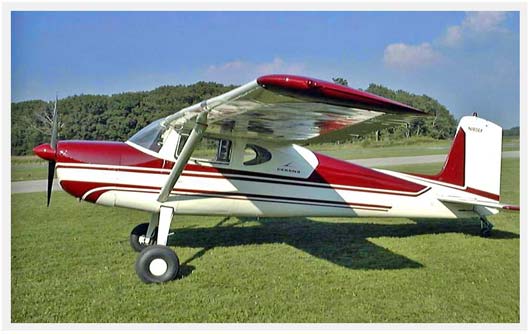This Is What The 1966 Cessna 150 Should Have Looked Like!
 Tuesday, March 9, 2010 at 08:12AM
Tuesday, March 9, 2010 at 08:12AM 
The recent post with the cool retro ad for the 1966 Cessna 150 has stirred up a lot of thoughts for me concerning the direction general aviation aircraft have taken over the last 50 years. I admit I’m extremely old-school when it comes to aircraft design, but that doesn't mean I’m old-fashioned. It has a lot more to do with the idea that an airplane should be designed in such a way that it stirs you emotionally. Great design means the airplane is certainly gonna perform as desired, that’s a must, but it should also do more than just move your body from point A to point B… it should move you on the inside too.
Having said all that, this beautiful airplane pictured here is what I wish Cessna would have done for the 1966 150. In my little fantasy world, this would have all happened after they had finally come to the realization that ‘progress’ was killing their little 2 seat airplane. What is pictured here is really a 1959 150 that was converted to a taildragger and then given a gorgeous paint job reminiscent of a classic Cessna 180 scheme. The work was done by the good people at TaildraggerAviation, and it’s pretty obvious to me that these people think like I do.
The transformation from a rather dumpy tri-gear putt putt to a lean looking and proud taildragger worthy of the coolest aviators is pretty amazing. I look at this picture and I think: I’d love to have one of those! And I can tell ya, I have never ever ‘wanted’ a Cessna 150 before, but they way this one looks changes all my thinking.
I would have been so pleased if Cessna had realized that the ’66 150 really needed to be a taildragger, for the good of aviation. I’m not suggesting that ALL airplanes drag their tail, but I would suggest that ALL students should learn from day one in a taildragger. It forces you to be a better pilot, and better pilots make the whole world of aviation a better place.
Lastly, I wish in 2006, 40 years after the 1966 150 introduced the swept tail and electric flaps, that Cessna would have jumped the tracks that lead to the Skycatcher and instead would have taken the bold step to re-introduce the 150 as it looks here. Resurrecting the old type certificate could have saved loads of money over starting from scratch, and since they wound up using the O-200 engine in the Skycatcher anyway, they could have skipped the LSA idea and made an airplane with real utility and buckets full of curb appeal. Oh, and maybe then they could have seen fit to build it in the U.S. too instead of China.
If you really wanna see what I think the modern 2 seater ought to look like, check out my DreamBird. I originally drew it with the 110hp Rotec radial in mind, but it would be even more fun with the 150hp : )














































































Reader Comments (5)
This specific taildragger conversion is called the 'David Lowe' STC which utilizes Cessna 140 gearboxes, stringers, tail brackets, etc. installed in predrilled bulkheads from the factory.
Upon further research, Cessna actually envisioned this specific design as their "Cessna 140C." We all know the Cessna 140A's had a half-tapering wing with plain flaps. However, several sources have said Cessna designed a Cessna 140B which was the same as a 140A but with Fowler type flaps (essentially Cessna 150 wings). The 140B design never made it into production since the original tail design wasn't big enough to deliver proper authority once the Fowler Flaps were all the way down. The engineers went back to the drawing boards and designed a Cessna 140 with Fowler Flaps, an 0-200, and a larger tail... the Cessna 140C... However, the Cessna 140C never made it to production and only 14 or so fuselages were built, placed in storage, and (rumor has it) were used as the first several Cessna 150 fuselages. For whatever reason, in 1959 the engineers decided to move a wheel to the other end of the fuselage and start a fire that would end up as the world's most popular trainer. It's hard to believe the 1977 Cessna 150M was originally spawned off of a Cessna 140 design, eh?
All fastback 150's (1959-1963) and the "omni-vision" straight tails (1964-1965) all have the same predrilled bulkheads that accept Cessna 120/140 gearboxes... But the David Lowe STC only allows fastbacks to be taildraggers through this specific conversion.
Hey Martt:
Sorry to tell ya, but this airplane was produced no later than the 1963 model 150C. The 1964 150D had an omni-vision rear window as mentioned above. The 150C made a wonderful taildragger with the big tail and Fowler flaps.
a.j.
Hello Martt
i'm an aerospace student and i have some questions. could you please send me an email to make contact with you.
thank you so much
meraj
sm.bousaki@gmail.com
We had the answer for 10 years in our N Z Syndicate. A French built Aerobat - FRA150L. Texas taildwheel kit plus 140hp Continental engine. C172 performance.and that 40o flap. Email me for pics.
This cracks me up! I said the exact same thing about Cessna and the Skycatcher upon seeing the picture of a C140 that had groundlooped.
Just now I was looking at a C150B in the local classifieds and started thinking about the two taildragger STCs available for the 150.
If 2023 hadn't been such a disastrous business year, I'd pull the trigger on the 150B and get the David Lowe conversion done to it.